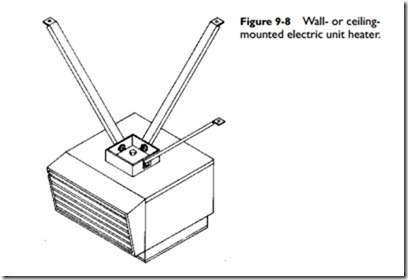Electric Unit Ventilators
Electric unit ventilators (similar in appearance to electric unit heaters, shown in the next section) are used to heat, ventilate, and cool large spaces that are by nature subject to periods in which there are high densities of occupancy. They are frequently found in offices, schools, auditoriums, and similar structures. The basic components of a typical unit ventilator are:
1. The housing
2. Motor and fans
3. Heating element
4. Dampers
5. Filters
6. Grilles or diffusers
Automatic controls activate the unit ventilator and vary the temperature of the air discharged into the room in accordance with room requirements. Outdoor air is drawn through louvers in the wall and into the unit ventilator before being discharged into the interior of the structure. These ventilators are usually floor- or ceiling-mounted, depending on the design of the room.
In addition to electricity, unit ventilators may also be gas-fired or use steam or hot water as the heat medium. Unit ventilators are described in greater detail in Chapter 2 of Volume 3, “Radiators, Convectors, and Unit Heaters.”
Electric Unit Heaters
Electric unit heaters (Figure 9-8) are used primarily for heating large spaces, such as offices, garages, warehouses, and similar commercial and industrial structures.
As is the case with unit ventilators, the heat-conveying medium and combustion source may be other than electricity. For example, the air may be heated by either gas-fired or oil-fired units. Steam or hot water can be substituted for air as the heat conveying medium. Selecting electricity as a medium will depend on such factors as:
1. The availability of cheap electrical power
2. The need for supplementary housing
3. The scarcity of other heat-conveying mediums
The typical unit heater contains the following basic components:
1. Fan and motor
2. Heating element
3. Directional outlet
4. Casing or housing
Unit heaters may be floor-mounted or suspended from the ceiling, depending upon the design requirements of the structure.
